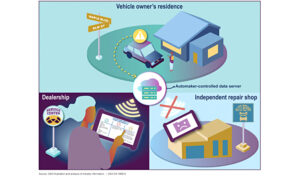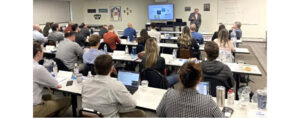The technology and infrastructure present challenges for driverless cars, though driverless big-rig trucks will become more likely in the next five years, according to study
Fort Wayne, Ind.—Significant progress has been made in driverless car technology, but many formidable challenges could delay, for decades, their widespread and everyday use, according Lang Marketing’s latest report.
“Driverless cars have the potential to reduce accidents, lower pollution, and provide a number of other significant benefits, but their presence on U.S. roads in great numbers across the country is much further into the future than most proponents currently claim,” states the study.
The focus of the report is driverless cars that operate without human assistance. Self-driving cars, on the other hand, require a human at the wheel to take control when the self-driving vehicle cannot effectively or safely operate. It’s findings and positions are as follows:
BENEFITS OF DRIVERLESS CARS
- The proponents of driverless cars claim that the new technology will reduce traffic congestion (along with air pollution), save countless lives, and provide an economic alternative to conventional vehicle ownership (transportation as a service).
- People will become more productive by using the hundreds of hours each year that a driverless vehicle would free them from being at the wheel.
MAJOR CHALLENGES TO OVERCOME
While proponents of the driverless car make claims about its many desirable benefits, a number of challenges must be overcome before cars can truly be self-driving (let alone driverless) with only selected human intervention required.
Roadway Mapping is a Substantial Barrier
- Extensive roadway mapping is necessary for driverless vehicles to operate widely.
- Although Waymo (Google) claims that its driverless fleet has travelled millions of virtual miles, these miles have been recorded on a limited circuit of roadways or in simulation.
- Today, less than 5 percent of all roads in the U.S. have been adequately mapped for driverless cars.
Inconsistent Road Conditions
- Even if roads are adequately mapped, the lanes on roads must be clearly marked, something that does not exist for most roadways.
- There are also variations in traffic configurations and countless other roadway features that driverless cars need to quickly identify and react to appropriately.
Challenging Weather Conditions
Driverless cars currently cannot operate in rain or snow. There are more than 100 days per year in many areas of the country during which driverless cars cannot operate with their current technology.
Special Driving Situations Abound
- Driverless cars, in their present state of development, cannot respond to numerous situations that commonly occur in everyday driving such as directions from a traffic officer, road construction, potholes, crossing yellow lines to avoid hitting obstacles, driving in parking lots, and other conditions that call for on-the-spot problem solving.
- This does not include what are called “corner events”: unusual conditions encountered by drivers that might happen only occasionally to an individual driver but occur many millions of times per year across the total driving population.
Hacking Threat
Driverless cars, with their total dependence on sensors and software, are vulnerable to hacking. Since sophisticated computer networks and systems are repeatedly hacked, there is little doubt that driverless car software would be highly venerable to hacking, with life and death consequences.
Liability and Legal Issues
Numerous liability and legal issues resulting from the malfunction of driverless cars present a road block to the advancement of these vehicles. Until these issues are resolved, the everyday use of driverless vehicles will be on hold.
Driver Confidence: Hard to Get but Easy to Lose
For driverless vehicles to gain wide acceptance, drivers and passengers must have confidence in their safety. Consumer confidence and acceptance can be difficult to obtain and would easily be affected if hacking occurs or flaws are found in the ability of driverless cars to properly and safely function in the wide variety of conditions that are faced every day.
Other Issues
Numerous other issues must be resolved before driverless cars are common across the country: more effective and affordable sensors, the willingness of Americans to “give up” the wheel to technology, and a massive upgrade to roadway infrastructure, among others.
DRIVERLESS HEAVY TRUCKS ARE ANOTHER MATTER
It is likely that within the next five years driverless big rigs will be operating on long-haul routes across the U.S. in relatively large numbers. Barring bad weather conditions, driverless trucks can operate on well-marked Interstate highways using technologies that exist today.
Even so, big rigs will need to be driven by humans for many years from their starting locations to the points at which they enter and exit the Interstate roadways. Driverless heavy trucks operating on well-defined interstate routes face many fewer operational challenges than driverless cars travelling under a myriad of traffic and roadway conditions.







Comments are closed.